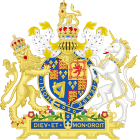| Act of Parliament | |
 | |
| Long title | An Act for repeal of a branch of a Statute primo Elizabethe concerning Commissioners for causes Ecclesiasticall. |
|---|---|
| Citation | 16 Cha. 1. c. 11 |
| Dates | |
| Royal assent | 5 July 1641[1] |
| Other legislation | |
| Repealed by | Ecclesiastical Jurisdiction Measure 1963 |
Status: Repealed | |
| Text of statute as originally enacted | |
The act 16 Cha. 1. c. 11,[2] sometimes referred to as the Ecclesiastical Causes Act 1640,[3] the Abolition of High Commission Court Act 1640,[4] the High Commission Abolition Act 1641,[5] the Abolition of the Court of High Commission Act,[6] the High Commission Court Abolition Act,[7] the Act for the Abolition of the High Commission,[1] the Act for the Abolition of the High Commission Court,[8] or the Act for the Abolition of the Court of High Commission,[9] was an Act of the Parliament of England, passed by the Long Parliament. It abolished the Court of High Commission and repealed the clause in the Act of Supremacy 1558 that gave the Court legal authority.[10] Horder said the Act 16 Cha. 1. c. 11 is "important".[11] It is a precursor to the Self-Incrimination Clause which is included in the Fifth Amendment to the United States Constitution.[12]
The whole Act was repealed by section 87 of, and the Fifth Schedule to, the Ecclesiastical Jurisdiction Measure 1963 (No 1).
- ^ a b Gardiner (ed). The Constitutional Documents of the Puritan Revolution, 1625-1660. Oxford. 1889. p xxxvi.
- ^ This act is sometimes cited as a statute of the session 17 Cha. 1; and it is cited as a statute of the session 17 Cha. 1 in the Act 13 Cha. 2. St. 1. c. 12: Halsbury's Statutes of England, 2nd Ed, 1949, vol 7, p 190; Day's Edition of East's Reports, Philadelphia, 1817, vol 14, footnote (e) to p 398.
- ^ Howell. The Judicial Committee of the Privy Council 1833-1876. Cambridge University Press. 1979. p 248. See further pp 4 & 19.
- ^ The Oxford Dictionary of the Christian Church, 3rd Ed, 2005, p 772
- ^ Fajgenbaum and Hanks. Australian Constitutional Law: Cases, Materials and Text. Butterworths. 1972. pp xxxii & 49. [1]
- ^ Sieghart. Government by Decree. Stevens. 1950. p xxiii. See further pp 31 & 45. [2]
- ^ Edgar Taylor, The Book of Rights, A Maxwell, 1833, pp 188 to 191.
- ^ (1912) 133 The Law Times 392 (24 August 1912)
- ^ Medley, Original Illustrations of English Constitutional History, 1910, p 293
- ^ Mark A. Thomson, A Constitutional History of England. 1642 to 1801 (London: Methuen, 1938), p. 136.
- ^ Horder, Ashworth's Principles of Criminal Law, 9th Ed, 2019, pp 26. And see also p 27.
- ^ Landmark Briefs and Arguments of the Supreme Court of the United States: Constitutional Law: 2007 Term Supplement. Volume 374: Boumediene v Bush (2008). p 9. [3] [4]. See further, Kemp, "The Background of the Fifth Amendment in English Law: A Study of Its Historical Implications" (1958) 1 William & Mary Law Review 247 at 284 (No 2, April 1958).